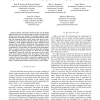Free Online Productivity Tools
i2Speak
i2Symbol
i2OCR
iTex2Img
iWeb2Print
iWeb2Shot
i2Type
iPdf2Split
iPdf2Merge
i2Bopomofo
i2Arabic
i2Style
i2Image
i2PDF
iLatex2Rtf
Sci2ools
IROS
2006
IEEE
2006
IEEE
Haptic cooperation between people, and between people and machines
— Haptic interaction between people and machines might benefit from an understanding of haptic communication between one person and another. We recently reported results showing that two people performing a physically shared dyadic task can outperform either person alone, even when the perception of each participant is that the other is a hindrance [1]. Evidently a dyad quickly negotiates a more efficient motion strategy than is available to individuals. This negotiation must take place through a haptic channel of communication, and it is apparently at a level below the awareness of the participants. Here we report results on the motion strategy that emerged. By recording forces and motions we show that the dyads “specialized” temporally such that one member took on early parts of the motion and the other late parts. Tests in which one participant’s contribution was surreptitiously replaced by a motor did not elicit a similar cooperative response from the remaining human part...
| Added | 12 Jun 2010 |
| Updated | 12 Jun 2010 |
| Type | Conference |
| Year | 2006 |
| Where | IROS |
| Authors | Kyle B. Reed, Michael A. Peshkin, Mitra J. Hartmann, James Patton, Peter M. Vishton, Marcia Grabowecky |
Comments (0)

